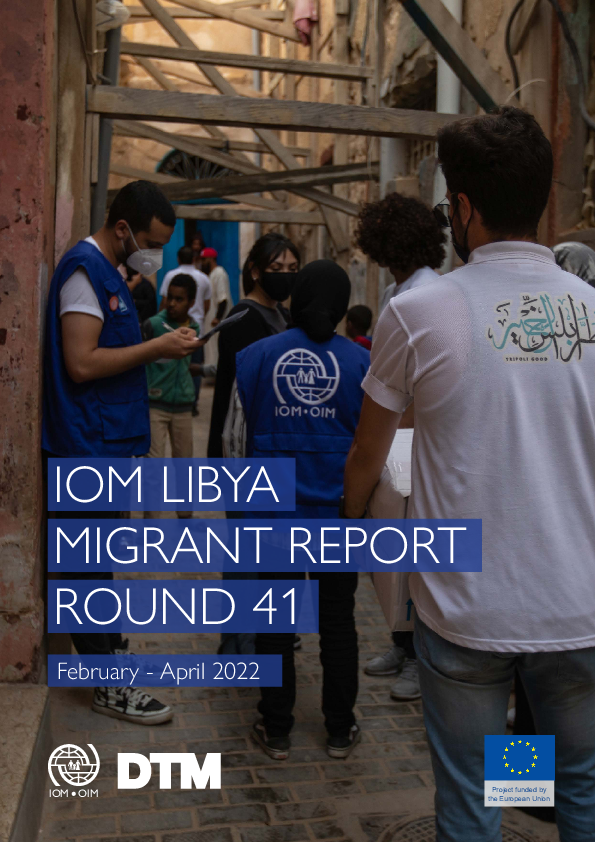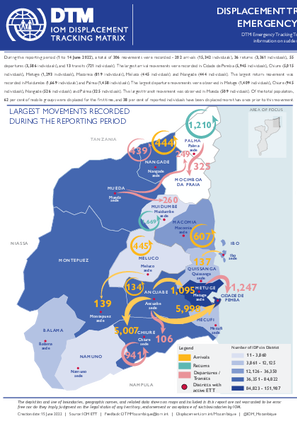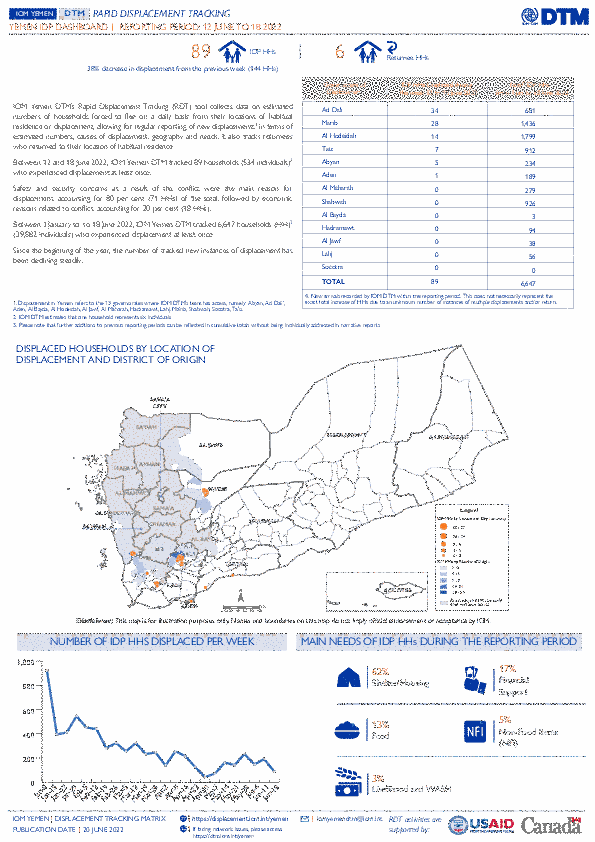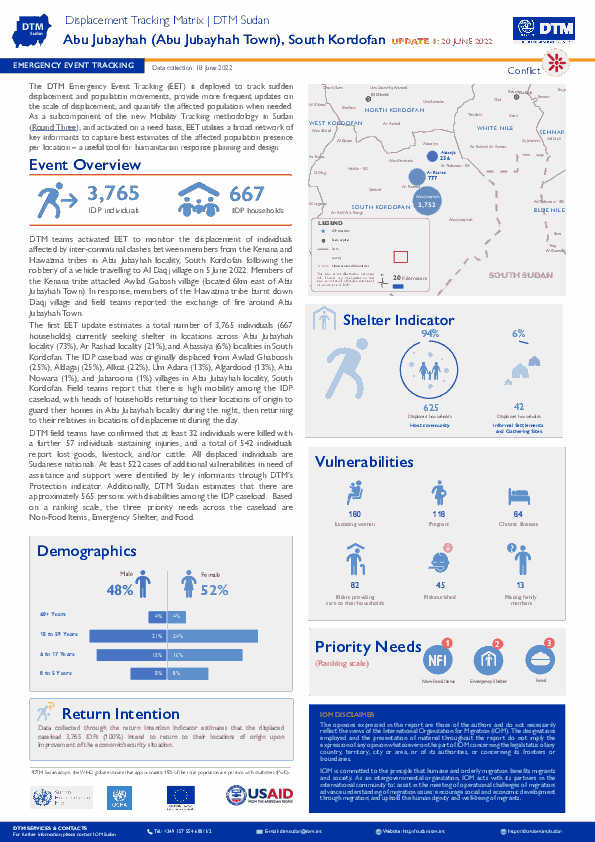-
Countries
-
Data and Analysis
-
Special Focus
-
Crisis Responses

Contact
DTM Nigeria, AllUsersInDTMNigeria@iom.int
Language
English
Location
Nigeria
Period Covered
Mar 01 2022
Mar 31 2022
Activity
- Flow Monitoring
In order to gain a better understanding of mobility flows and trends throughout West and Central Africa, the International Organization for Migration (IOM) implements the Displacement Tracking Matrix’s Flow Monitoring (FM) tool at key transit points across the region. Flow Monitoring activities are conducted in close cooperation with national and local authorities as well as with local partners. The Flow Monitoring tool consists of two main components: the Flow Monitoring Registry (FMR), which captures key data on the magnitude, provenance, destination and mode of travel of mobility flows, and the Flow Monitoring Survey (FMS), individual surveys conducted with travellers to gather detailed information about the profiles, migration experience, and intentions of migrants. Through these activities, the Flow Monitoring tool collects data on migration flows and trends, traveller profiles, migration journeys, and intentions of migrants, so as to obtain a sharpened view of mobility in West and Central Africa.
In Nigeria, DTM conducts Flow Monitoring activities in several important transit locations in Sokoto and Kano to monitor the movements of passenger buses to and from Niger. The Sokoto FMP covers three migratory routes in Illela, Gada and Sabon-Birnin. And the Kano FMP (Kofar Ruwa Park and Yankaba Park) covers two migratory routes in Dala and Nasarawa Local Government Areas in Kano state.
This report is subdivided into two sections: one section presents data obtained during the Flow Monitoring Registry and another section presents the key results from the Flow Monitoring Survey conducted with travellers between February and March 2022. The report presents data collected on flows, routes, provenance, destination and demographic profiles of travellers observed at the FMPs.
Contact
dtmlibya@iom.int
Location
Libya
Activity
- Mobility Tracking
- Baseline Assessment
Period Covered
Feb 01 2022 -Apr 30 2022
A baseline assessment is a sub-component of mobility tracking. It aims to collect data on IDP, migrant or returnee population presence in a defined administrative area of the country.
Population Groups
Survey Methodology
Unit of Analysis Or Observation
Type of Survey or Assessment
Keywords
Geographical Scope
Administrative boundaries with available data
The current dataset covers the following administrative boundaries

Contact
DTM Libya, DTMLibya@iom.int
Language
English
Location
Libya
Snapshot Date
Apr 30 2022
Activity
- Flow Monitoring
- Mobility Tracking
- Baseline Assessment
This infographic presents the key findings of Round 41 of the mobility tracking component of the Displacement Tracking Matrix (DTM) programme in Libya.

Contact
DTM Libya, DTMLibya@iom.int
Language
English
Location
Libya
Period Covered
Feb 01 2022
Apr 30 2022
Activity
- Flow Monitoring
- Migrants presence
- Mobility Tracking
- Baseline Assessment
IOM Libya’s Displacement Tracking Matrix (DTM) programme identified a total of 649,788 migrants from over 41 nationalities in the 100 Libyan municipalities during Round 41 of data collection (February - April 2022). In line with a trend that started at the beginning of 2021, data collected by DTM Libya shows that the number of migrants in Libya has continued to increase compared to the previous reporting period (635,051 migrants, Round 40, January 2022) (Fig 1). In 2020, the number of migrants in Libya declined as a result of the COVID-19 pandemic and the ensuing mobility restrictions, security controls as well as economic downturn. While the removal of the COVID-19 related mobility restrictions, improvement in the labour market (as seen in the reduced migrant unemployment rate) and cessation of armed conflict may have contributed to an increase in the number of migrants, this trend also corresponds with the arrival of seasonal migrant workers in Libya (generally between March and May).

Contact
DTMMozambique@iom.int
Language
English
Location
Mozambique
Period Covered
Jun 01 2022
Jun 14 2022
Activity
- Mobility Tracking
- Event Tracking
During the reporting period (1 to 14 June 2022), a total of 306 movements were recorded - 202 arrivals (15,342 individuals), 36 returns (3,361 individuals), 55 departures (3,586 individuals), and 13 transits (721 individuals). The largest arrival movements were recorded in Cidade de Pemba (5,945 individuals), Chiure (5,015 individuals), Metuge (1,293 individuals), Macomia (819 individuals), Meluco (445 individuals) and Nangade (444 individuals). The largest return movement was recorded in Muidumbe (1,669 individuals) and Palma (1,458 individuals). The largest departure movements were observed in Metuge (1,409 individuals), Chiure (945 individuals), Nangade (526 individuals) and Palma (325 individuals). The largest transit movement was observed in Mueda (509 individuals). Of the total population, 62 per cent of mobile groups were displaced for the first time, and 38 per cent of reported individuals have been displaced more than once prior to this movement.
Contact
DTM Yemen, iomyemendtm@iom.int
Location
Yemen
Activity
- Mobility Tracking
- Event Tracking
Period Covered
Jun 12 2022 -Jun 18 2022
IOM Yemen DTM’s Rapid Displacement Tracking (RDT) tool collects data on estimated numbers of households forced to flee on a daily basis from their locations of origin or displacement, allowing for regular reporting of new displacements in terms of estimated numbers, geography, and needs. It also tracks returnees who returned to their location of origin.
From 1 January to 18 June 2022, IOM Yemen DTM tracked 6,647 households (HH) (39,882 Individuals) who experienced displacement at least once.
Between 12 and 18 June 2022, IOM Yemen DTM tracked 89 households (534 individuals) displaced at least once. The majority of people moved into/within the following governorates and districts:
• Ad Dali (34 HHs) – Qatabah (22 HHs), Ad Dali (12 HHs) districts. Most displacements in the governorate originated from Ad Dali and Ibb.
• Marib (28 HHs) – Marib (17 HHs), Marib City (11 HHs) districts. Most displacements in the governorate originated from Marib and Al Hodeidah.
• Al Hodeidah (14 HHs) – Hays (14 HHs) district. Most displacements in the governorate were internal.
The majority of people moved from the following governorates and districts:
• Al Hodeidah (27 HHs) – Hays (15 HHs), Al Marawiah (3 HHs), Al Hali (3 HHs) districts.
• Ad Dali (17 HHs) – Qatabah (10 HHs), Al Husha (4 HHs), Ad Dali (1 HHs) districts.
• Taiz (11 HHs) – Maqbanah (5 HHs), Mawza (3 HHs), At Taiziyah (1 HHs) districts.
Population Groups
Survey Methodology
Unit of Analysis Or Observation
Type of Survey or Assessment
Keywords
Geographical Scope
Administrative boundaries with available data
The current dataset covers the following administrative boundaries

Contact
DTM Yemen, iomyemendtm@iom.int
Language
English
Location
Yemen
Period Covered
Jun 12 2022
Jun 18 2022
Activity
- Mobility Tracking
IOM Yemen DTM’s Rapid Displacement Tracking (RDT) tool collects data on estimated numbers of households forced to flee on a daily basis from their locations of origin or displacement, allowing for regular reporting of new displacements in terms of estimated numbers, geography, and needs. It also tracks returnees who returned to their location of origin.
From 1 January to 18 June 2022, IOM Yemen DTM tracked 6,647 households (HH) (39,882 Individuals) who experienced displacement at least once.
Between 12 and 18 June 2022, IOM Yemen DTM tracked 89 households (534 individuals) displaced at least once. The majority of people moved into/within the following governorates and districts:
- Ad Dali (34 HHs) – Qatabah (22 HHs), Ad Dali (12 HHs) districts. Most displacements in the governorate originated from Ad Dali and Ibb.
- Marib (28 HHs) – Marib (17 HHs), Marib City (11 HHs) districts. Most displacements in the governorate originated from Marib and Al Hodeidah.
- Al Hodeidah (14 HHs) – Hays (14 HHs) district. Most displacements in the governorate were internal.
The majority of people moved from the following governorates and districts:
- Al Hodeidah (27 HHs) – Hays (15 HHs), Al Marawiah (3 HHs), Al Hali (3 HHs) districts.
- Ad Dali (17 HHs) – Qatabah (10 HHs), Al Husha (4 HHs), Ad Dali (1 HHs) districts.
- Taiz (11 HHs) – Maqbanah (5 HHs), Mawza (3 HHs), At Taiziyah (1 HHs) districts.

Contact
DTMMozambique@iom.int
Language
English
Location
Mozambique
Period Covered
Jun 02 2022
Jun 16 2022
Activity
- Mobility Tracking
- Event Tracking
Fear of attacks and subsequent confirmed attacks in Ancuabe district by Non-State Armed Groups triggered the movements of 20,339 individuals within Ancuabe, Chiure, Quissanga, Balama, Mecufi, Mueda, Macomia, Montepuez, Meluco, Namuno, Nampula, Balama, Metuge and Cidade de Pemba. Approximately 927 IDPs have been identified with vulnerabilities. At
least 39% of these movements are arrivals in Cidade de Pemba and 29% in Chiure. New arrivals recorded within this report map 3,386 individuals predominantly moving into sites across Chiure, Metuge and Ancuabe.
The objective of the Emergency Tracking Tool (ETT) - Movement Alert is to collect information on large and sudden population movements, and to provide support to humanitarian response partners by disseminating data on IDPs for ensuring effective humanitarian response to the affected population. Information is collected through key informant interviews or direct observation. The dashboard provides basic information on displacements, and additional information can be shared upon request. IOM identified 17,691 individual displacement movements in the previous reporting period (02-15 June). Impact of new attacks reported between 9 and 13 June in Ancuabe and Chiure districts account for the increase of displacement movements representing 20,339 individuals. Current figures are to be considered as cumulative displacement movements observed between 02-16 June.

Contact
DTM Sudan; dtmsudan@iom.int
Language
English
Location
Sudan
Snapshot Date
Jun 18 2022
Activity
- Mobility Tracking
- Event Tracking
The DTM Emergency Event Tracking (EET) is deployed to track sudden displacement and population movements, provide more frequent updates on the scale of displacement, and quantify the affected population when needed. As a subcomponent of the new Mobility Tracking methodology in Sudan (Round Three), and activated on a need basis, EET utilises a broad network of key informants to capture best estimates of the affected population presence per location – a useful tool for humanitarian response planning and design.

Contact
DTM Cameroon, DTMCameroun@iom.int
Language
French
Location
Cameroon
Period Covered
Jun 12 2022
Jun 16 2022
Activity
- Mobility Tracking
- Event Tracking
L’objectif de l’outil de suivi des urgences est de rassembler des informations sur les mouvements significatifs et soudains de populations. Ce tableau de bord présente des informations sur des mouvements déplacements de personnes survenus entre le 12 et 16 juin 2022 dans la localité de Ndrock, arrondissement du Mokolo (département du Mayo-Tsanaga) dans la région de l’Extrême-Nord.